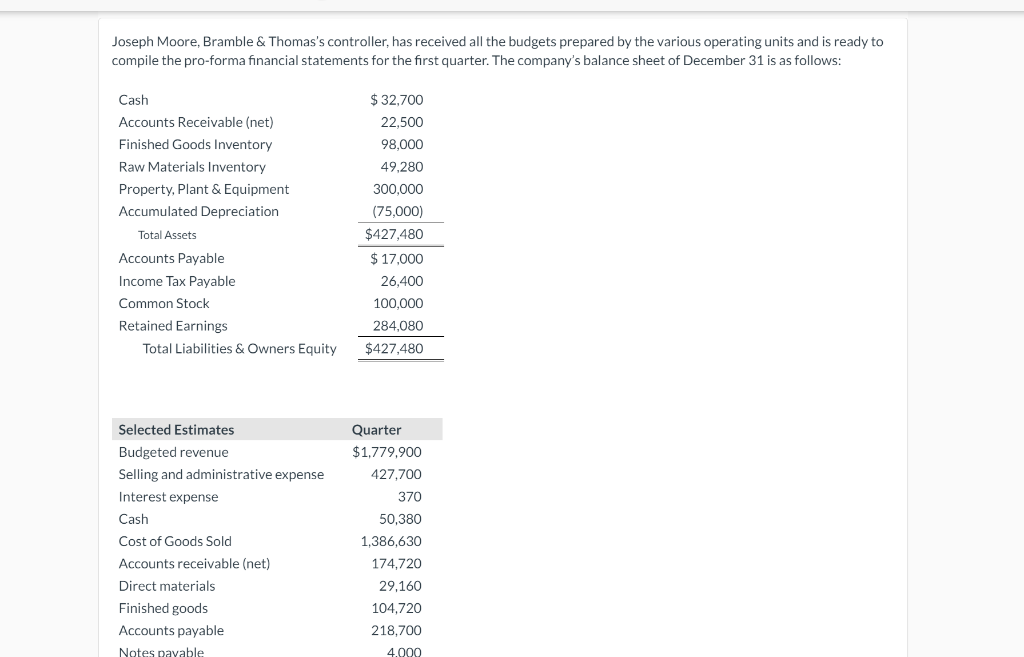



Joseph Moore, Bramble & Thomas's controller, has received all the budgets prepared by the various operating units and is ready to compile the pro-forma financial statements for the first quarter. The company's balance sheet of December 31 is as follows: Cash Accounts Receivable (net) Finished Goods Inventory Raw Materials Inventory Property, Plant & Equipment Accumulated Depreciation Total Assets $32.700 22,500 98,000 49.280 300.000 (75,000) $427.480 Accounts Payable Income Tax Payable Common Stock Retained Earnings Total Liabilities & Owners Equity $ 17,000 26,400 100,000 284,080 $427,480 Selected Estimates Budgeted revenue Selling and administrative expense Interest expense Cash Cost of Goods Sold Accounts receivable (net) Direct materials Finished goods Accounts payable Notes payable Quarter $1,779,900 427,700 370 50,380 1,386,630 174,720 29,160 104,720 218,700 4.000 Quarter $1,779,900 427,700 370 50,380 Selected Estimates Budgeted revenue Selling and administrative expense Interest expense Cash Cost of Goods Sold Accounts receivable (net) Direct materials Finished goods Accounts payable Notes payable 1,386,630 174,720 29,160 104,720 218,700 4,000 Additional Information: Bramble & Thomas plans to purchase and pay cash for a piece of land in February at a cost of $90,000. Bramble & Thomas plans to purchase equipment in March at a cost of $30,000. Depreciation for manufacturing overhead $42,000 per quarter and for selling and administrative $30,000 per month. The company expects a 30% income tax rate, and all quarterly taxes are paid in the first month of the following quarter. Matthew Young, Sheffield & Young Fabricators' production manager, has just received the company's sales budget for the first quarter. Budgeted units sold Budgeted sales price Budgeted revenue January February March Quarter 26,000 30,000 32,000 88,000 $24 $24 $24 $24 $624,000 $720,000 $768,000 $2,112,000 Budgeted sales of April is 33,000. Company policy requires an ending finished goods inventory each month that will meet 30% of the following month's sales volume. Matthew plans to have 3,400 finished bricks at a cost of $49,280 in inventory at the beginning of the year. Prepare Sheffield & Young's production budget for the first quarter. January February March Joshua Hill, Vaughn & Hill Fabricators' production manager, has just completed the company's production budget and direct labor budget for the first quarter. February 30,000 Quarter 84.000 7,200 Budgeted unit sales + Budgeted ending inventory Total units required Beginning inventory Budgeted production January 22,000 6,000 28,000 2,600 25,400 6,400 36,400 6,000 30,400 March 32,000 7,200 39,200 6,400 32.800 91,200 2,600 88,600 Quarter 88,600 0.20 Budgeted production Standard DLH per unit Total DLH required Standard wage rate Budgeted DL cost January 25,400 0.20 5,460 $17 $92,820 February 30,400 0.20 5,980 $17 $101,660 March 32,800 0.20 6,580 $17 $111,860 17,720 $17 $306,340 He has identified the following monthly expenses that will be needed to support the company's manufacturing process. Variable Overhead per DLH Depreciation Indirect materials Indirect labor Utilities Property taxes Fixed Overhead per month $32,000 18.200 24,000 18.000 $1.40 $0.20 $0.15 4,300










